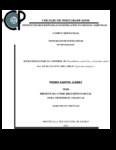Estrategias para el control de Phytophthora capsici Leo y Fusarium solani Mart en el cultivo del chile (Capsicum annuum L)
Abstract
Phytophthora capsici, Fusarium sp. y Rhizoctonia solani son los principales agentes causales de la marchitez del chile que disminuye el rendimiento del cultivo, lo cual ha originado la sustitución de cultivos y abandono de tierras. Con el fin de coadyuvar al manejo de esta enfermedad en el presente trabajo se evaluaron 51 accesiones de chile (árbol, copi y soledad) para buscar fuentes de resistencia; se probó metalaxyl, fosetil aluminio y tiabendazol para evaluar la sensibilidad de un aislamiento de P. capsici y se evaluó el Serrano Criollo de Morelos 334 (SCM334) resistente a P. capsici como portainjerto de las variedades susceptibles para el manejo de la marchitez del chile. El análisis de los resultados muestra que P. capsici tiene una sensibilidad intermedia a metalaxyl y sensible a fosetil aluminio y tiabendazol; la accesión CP1063 de chile de árbol es resistente a este patógeno, el resto de las accesiones mostraron cierto nivel de resistencia o fueron muy susceptibles. De los cuatro tipos de chile injertados sobre el criollo SCM334, no todos los tipos fueron compatibles con el SCM334 (serrano, morrón y jalapeño). En el tipo compatible (poblano), el injerto evitó la infección de P. capsici, pero no la de Fusarium solani. El uso del criollo de Morelos (SCM334) y CP1063 representan una alternativa de manejo de Phytopthora capsici. _______________ ABSTRACT: Phytophthora capsici, Fusarium sp. and Rhizoctonia solani are the main causal agents of wilt of pepper that significantly reduces yield, inducing that growers change crops and abandone land areas that are infested with these pathogens. Our goal was to collaborate to the management of the disease, evaluating 51 pepper accessions (árbol, copi y soledad) to look for resistance; We also test the sensitivity of P. capsici to metalaxyl, fosetil aluminio and tiabendazol and evaluated the Serrano Criollo de Morelos 334 (SCM334, resistant to P. capsici) as rootstock of susceptible varieties. Our results show that P. capsici is intermediately sensitive to metalaxyl y sensitive to fosetil aluminio and tiabendazol; accession CP1063 of chile de árbol is resistente to P. capsici. The rest of accessions only showed partial resistance or were susceptible to the pathogen. Four types of pepper were grafted on SCM334, but serrano, morrón and jalapeño were incompatible. Poblano type was compatible to SCM334 that avoid infection of P. capsici, but not of Fusarium solani. Criollo de Morelos (SCM334) and CP1063 are an alternative of management of the wilt produced by Phytopthora capsici.
Collections
- Tesis MC, MT, MP y DC [221]

